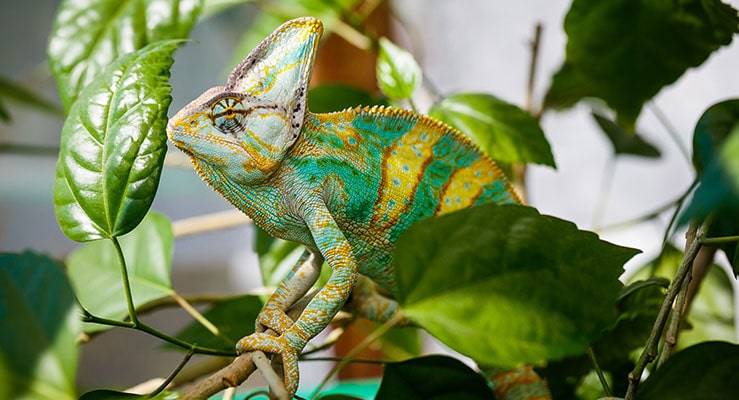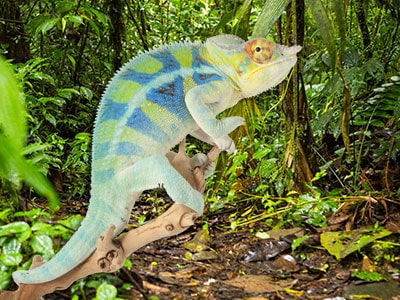- What to Consider Before Picking Plants
- Plant Toxicity
- Type of Reptile
- Light
- Humidity
- Benefits of Using Natural Plants Instead of Fake Plants
- Purify Indoor Air
- Increase Oxygen Levels
- Maintain High-Humidity Level
- Keep Your Vivarium Clean
- Reptile Safe Plants
- Peperomia
- Bromeliads
- Ferns
- Orchids
- Aloe vera
- Echeveria
- More Reptile Non-Toxic Plants
- Final Thoughts
If you are someone who is allergic to pet hair or someone who doesn't like to take his dog out for walks, a reptile might be the ideal pet for you.
First off, no loud noises, unlike birds, cats, or dogs, which bark, whine, or sing even in the middle of the night. Second, you don’t have to worry about pet hair on your carpet, rugs, or upholstery.
Reptiles do not have fur. Many species do shed their skin, but they usually do that in their enclosure, not on your couch.
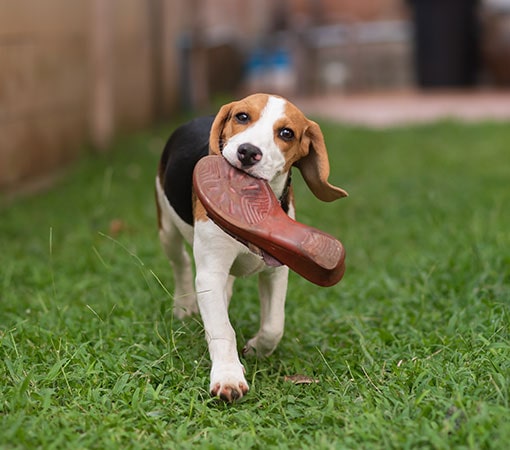
Last, no damage to your shoes or cushions. As you already know, dogs eat your couch cushions or chew your shows. With a reptile as a pet, you don’t have to worry about this aspect.
Most people prefer reptiles as display pets. As such, they build enclosures as a home for their reptiles. Since they are display animals, it’s wise to add habitat décor.
Many reptile owners may choose to use fake plants because they are cheap and easy to maintain. However, natural plants are way better for a number of reasons (we'll talk more about this below).
You need to keep in mind though that you cannot use any plant you find visually appealing.
There are many plants that are toxic to reptiles and using in your reptile's enclosure might result in getting your loved pet sick or worse. You need to avoid these plant types at all costs.
So, how do you know which plants are 100% safe to use in your reptile's enclosure? Well, continue reading.
Further, we'll cover the most important factors to consider before choosing the plants for your reptile enclosure and the benefits of real plants over artificial ones.
What to Consider Before Picking Plants
Finding live decorative plants that are 100% safe for your reptile pets is not always easy. Before picking plants for your vivarium, it’s essential to take into consideration a few factors concerning both the health of your animal and the optimal conditions for the development of plants in that habitat.
Plant Toxicity
Before you even consider the type of reptile, and humidity level, consider the plant’s toxicity. Some plants are poisonous to your amphibian or reptile. Such plants include the English Ivy, Peace Lillies, Wandering Jew, and daffodils.
These plants have chemicals or toxins that are harmful or irritating to your pet. As you probably know, there are omnivorous reptiles such as the crested gecko who might consume the leaves or different parts of these plants.
To eliminate any risks, use only the plants which are considered 100% safe or talk to a pet store owner. He can point out which plants are known to be toxic to reptiles and which are non-toxic.
Also, keep in mind that some plants might be 100% safe for other animals, but might cause indigestion or other intoxications to reptiles, so be extremely cautious.
Type of Reptile
Many people do not know that the extra cover given by real plants in an enclosure offers security to the reptile. As such, it results in more natural behavior. In some cases, reptiles incorporate the live plants in their breeding cycles.
This is why reptile pet owners need to match the reptile to the right plants. Terrariums are a stable environment for reptiles. Despite this, it’s impossible to provide a variety of seasons as found in nature.
So, when choosing plants for your enclosure, consider the reptile’s habits and breeding cycles. For example, we know tropical geckos make good vivarium inhabitants. Other reptiles include small agamid lizards, dart frogs, and chameleons.
By taking into account if the species is omnivorous or herbivorous, you can provide reptile safe plants they can feed on.
Light
The best light for your vivarium is that which your amphibian or reptile needs. Therefore, you need to choose plants accordingly.
Many times the natural light will not be enough, so people may opt for softer, moderate artificial lights. These types of lights are flexible and will be suitable for many plants.
Others may opt for bright, hot lights. Such lights cast sharp shadows.
Using artificial light allows you to control the intensity and duration and might allow you to choose from a wider range of plants. However, that might result in additional expenses.
Some reptiles require high temperatures, such as the bearded dragons and the lizards in the Uromastyx genus. High temperatures dry the air making it difficult for some plants to thrive.
The good news is there is a variety of plants can survive in high temperatures and are known as non-toxic to reptiles. Two of the most common plants in this category are Aloe Vera and Echeveria.
If you choose the most suitable plants for your vivarium right from the start based on the actual conditions, it will help you save money later because you won't have to invest in special artificial lighting devices.
Remember that many plants rely on UV light to grow and thrive. Make sure your lights offer enough on the UV spectrum, even if you use artificial lighting.
If the natural light is not enough, you might need to use a full spectrum LED grow light which imitates the natural sunlight. However, these might be quite pricey.
Humidity
A majority of reptiles love a tropical habitat. Such reptiles and amphibians include dart frogs and bearded dragons. In fact, bearded dragons require an ideal humidity level of between 30 to 40%, day and night.
The best reptile non-toxic plants for a tropical vivarium are the staghorn fern, bromeliads, and orchids. They can thrive in temperatures of 29 to 30 degrees C and can increase humidity levels in the enclosure. By doing so, they keep the air composition healthy and balanced.
This is because they use carbon dioxide and remove toxic gases replacing them with oxygen. Despite having the right tropical plants, other factors such as fans and ACs may interfere with humidity levels.
So, it’s important to monitor humidity levels in the enclosure regularly. To do so, use reliable thermometers, thermostats, and hygrometers.
Benefits of Using Natural Plants Instead of Fake Plants
Plastic plants for reptile enclosures look like the real thing. They require no watering or the use of specialized expensive artificial lighting systems.
I find it truly amazing how some artificial decorative plants imitate the live ones. Many times, it's hard to tell that a plant is made out of plastic without touching it.
So, why should you choose live plants instead of just using artificial plants?
Purify Indoor Air
Live plants purify indoor air, in the room, and the reptile enclosure. They can do so by removing carbon dioxide, toxic gases, and airborne contaminants. Research by NASA specialists proved that live plants can remove toxic pollutants from the air.
Such pollutants include VOC compounds, ammonia, and formaldehyde. These compounds can be harmful to you, your family, and your pets. In fact, research shows that they have serious health effects such as asthma.
So, if you want your pet to breathe cleaner air, do not use plastic plants, but live plants.
Increase Oxygen Levels
The best gift from Mother Nature is oxygen. To breathe fresh air we need live plants to produce that oxygen. Plants take in carbon dioxide and replenish the air with oxygen. When you have plants in your reptile enclosure, your pet will continue to thrive without the need for expensive equipment to purify the air.
Maintain High-Humidity Level
Some reptiles require a humid environment to thrive. Humidity is vital for normal functions and proper shedding. Fake plants cannot aid in maintaining humidity levels or clean your vivarium. Why, you may ask. It's because they are fake.
But live plants can. This is because they require water and soil to grow. As such, through respiration, plants will help to put water back into the air. This helps to create a humid microclimate for your reptile pet.
Keep Your Vivarium Clean
Reptiles and plants produce waste such as dead leaves and fecal matter. Cleaning the enclosure every day to remove the waste is time-consuming. To ease the workload, some pet owners may decide to add microfauna in the enclosure.
Just as the process functions in nature, the microfauna will feed on the waste and break it down into a simpler and non-harmful form. Plants feed on this and grow. As such, they help to keep the enclosure clean and prevent the accumulation of waste.
Now that you know several of the benefits of using real live plants instead of artificial ones, it's time to name a list of the most common plants which are widely considered 100% safe for reptiles and which can be harmlessly used in your reptile enclosure.
Reptile Safe Plants
If you have an omnivore or herbivore as a pet in your reptile enclosure, you must buy non-toxic plants. Here is a rundown of safe plants for your reptile enclosure.
Peperomia
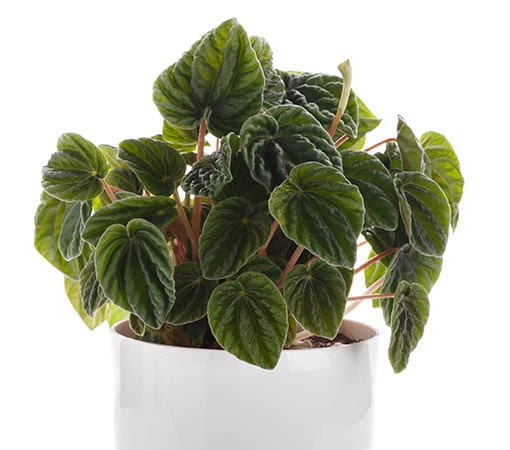
If you plan on keeping dart frogs as pets, then this plant is safe for use in the enclosure. As you already know, dart frogs require a humid environment. Peperomia grows in low light and has tiny to large leaves. They are compact in form and are easy growers.
What you need to know is that you can incorporate different forms of peperomia in your enclosure. This is because there are hundreds of species to choose from.
Bromeliads
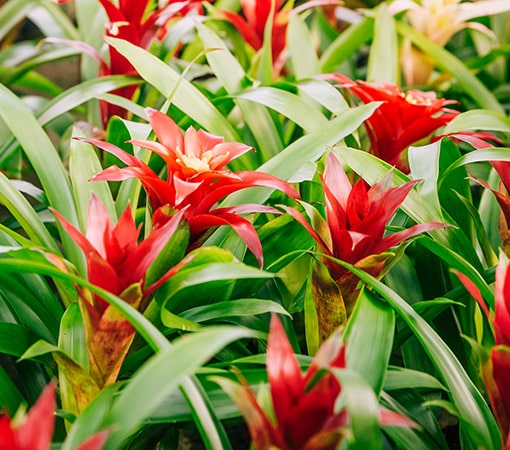
Another safe plant perfect for a humid environment is the bromeliads. The most common genus is Neoregelia. As true epiphytes, they flower and will grow fine on a stick or stuck on the ground.
Since they are adaptable and compact, you can plant them in moss or soil. We mainly prefer Donger or Fireball as they are inexpensive and readily available. These plants grow in medium light.
Try to avoid most tillandsias as they have a powdery silver coating on their leaves.
Ferns
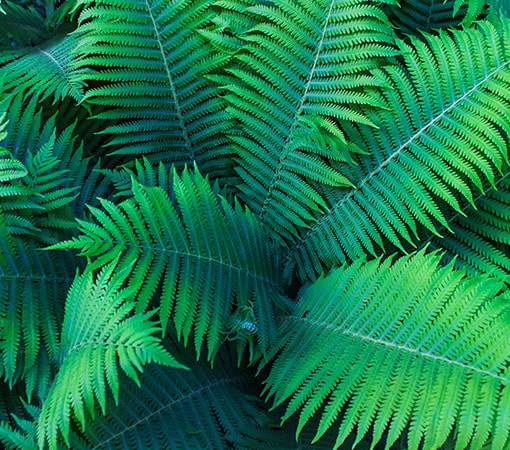
No other plant creates a humid environment in a reptile enclosure like ferns. Great with low light, they are easy to grow and maintain. Ferns such as the staghorn make great display plants thanks to their size. In fact, you can add a couple of them in your home using hanging baskets.
They have interesting fronds and are good on the fringe of a habitat. Besides the staghorn fern, you also have the bird nest fern and Boston fern. Both are easy to grow and require medium-light. Thanks to their large leaves, they provide coverage to little critters.
Orchids

Orchids add a special touch in your vivarium. As epiphytes, they don’t like having soggy roots. But they do provide beautiful foliage and require relatively low light to grow. So, when growing orchids, plant them in an area where they will not be constantly wet.
Some of the best orchids to consider are the Macodes petola, and Ludisia discolor. As jewel orchids, they have beautiful foliage. You can also add the pink rock orchids, which offers many blooms of pinky-purple flowers.
Aloe vera

If planning on keeping a bearded dragon, then you need a desert-like vivarium. One of the best, reptile non-toxic plants that can endure the high temperatures is the aloe vera. As a succulent plant, its evergreen and grows wild in tropical and arid areas.
This is one of the best-potted plants that is more than a decoration. Aloe vera sap can relieve heartburn, lower your blood sugar, and great for skin care. To plant aloe vera in your enclosure, we recommend the use of a terra cotta pot.
Add well-drained dirt or equal parts of potting soil and sand. Only water the plants when the earth is dry.
Echeveria
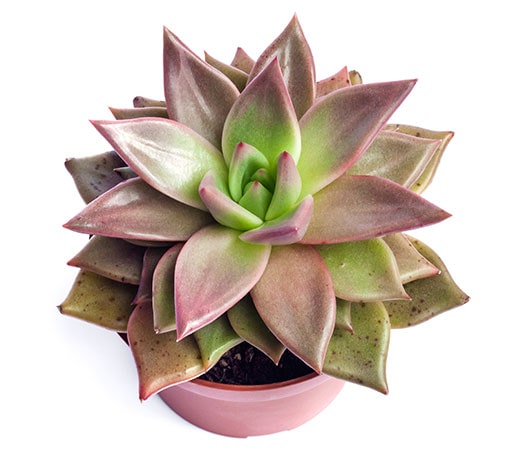
Another succulent plant perfect for your desert-like vivarium is echeveria. With fleshy leaves and a waxy cuticle exterior, this plant is native to semi-desert areas.
Beautiful and evergreen, they have brightly colored leaves that grow on short stalks. What you need to know is that the echeveria is a polycarpic plant. This means it can flower and seed several times during its lifetime.
Best echeveria species to grow are the echeveria elegans and echeveria laui.
More Reptile Non-Toxic Plants
This following list has been compiled from multiple sources and I cannot guarantee the accuracy of the information or the fact that all the listed plants are 100% safe for reptiles.
Even though the majority of them are labeled as non-toxic for dogs and cats, I strongly advise you to ask for the advice of a veterinary or a pet store before using the plants in the enclosure of your reptile.
I recommend you using the plants listed below only as a starting point for your research. Moreover, I encourage you to conduct your own analysis before picking the plants.
| Common Name | Scientific Name | Also Known As |
|---|---|---|
| Abelia | Abelia grandiflora | Glossy Abelia |
| African Violet | Saintpaulia ionantha | Saintpaulia |
| Ponytail Plant | Beaucarnea recurvata | The elephant's foot |
| Zebra Plant | Calathea zebrina | - |
| Paddys Wig | Soleirolia soleirolii | Baby's tears, Angel's tears, Friendship plant |
| Bamboo | Phyllostachys aurea | Fishpole bamboo, Golden bamboo |
| Bird's nest fern | Asplenium nidus | Nest fern |
| Sword fern | Nephrolepis exaltata | Boston fern |
| Purple Velvet Plant | Gynura aurantica | Royal Velvet Plant, Purple Passion Vine |
| Sweet Alyssum | Lobularia maritima | Sweet alison, Alyssum |
| Swedish Ivy | Plectranthus australis | Creeping Charlie |
| Staghorn Fern | Platycerium bifurcatum | Elkhorn fern |
| Christmas Cactus | Schlumbergera bridgesii | Easter Cactus, Forest cactus |
| Zebra Haworthia | Haworthia fasciata | Zebra Plant |
| Sky plant | Tillandsia ionantha | Airplant |
| Buchanan's Sedge | Carex buchananii | Cutty grass |
| Aeonium | Aeonium | Tree houseleek |
| Emerald Ripple | Peperomia caperata | Peperomia |
| Pachyveria | × Pachyveria | Little Jewel |
| Lithops | Lithops | Living stone |
| Hibiscus | Hibiscus syriacus | Rose of Sharon, Rose of China |
| Jasmine | Jasminium species | Common jasmine |
| Sempervivum | Sempervivum | Hen And Chicks, Semps, Houseleeks |
| Ribbon Plant | Chlorophytum comosum | Anthericum, Spider ivy, Spider plant |
Final Thoughts
Before buying these reptile non-toxic plants, check for pests. Such pests include aphids, snails, earwigs, sowbugs, and mealy bugs.
It’s essential to check the stem, roots, base, leaves, and the top layer of potting mix. If you discover any pests, it’s best not to buy the plant. The reason why you need a pest-free plant is that once you introduce pests in your enclosure, it’s hard to get rid of them.
Besides checking the plant for pests, consider its overall health. If it has discolored or dropping leaves, mushy or soft stems, and its wilting, avoid the plant.
Always buy from reputable vendors.

